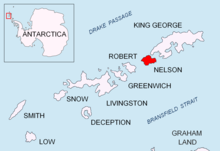WASP-50
WASP-50| 관측 데이터 에폭 J2000 이쿼녹스 J2000 | |
|---|---|
| 별자리 | 에리다누스 |
| 우측 상승 | 02h 54m 45.1343s[1] |
| 탈위임 | −10° 53′ 53.0260″[1] |
| 겉보기 크기 (V) | 11.44 |
| 특성. | |
| 스펙트럼형 | G9V |
| 아스트로메트리 | |
| 방사 속도 (Rv) | 25.24km/s |
| 고유 운동 (μ) | RA: 3.281 마스/yr Dec.: 8.963 마스/yr |
| 시차 (π) | 5.3816 ± 0.0540[1] 마스 |
| 거리 | 606 ± 6 리 (102 ± 2 pc) |
| 세부사항[2][3] | |
| 미사 | 0.892+0.08 −0.074 M☉ |
| 반지름 | 0.843±0.031 R☉ |
| 표면 중력 (log g) | 4.5±0.1 cgs |
| 온도 | 5400±100K |
| 금속성 | −0.12±0.08 |
| 회전 | 16.30 ± 0.50 d |
| 회전 속도 (v sin i) | 2.6±0.5km/s |
| 나이 | 8.57±2.86 Gyr |
| 기타 지정 | |
| 데이터베이스 참조 | |
| 심바드 | 자료 |
WASP-50은 약 610광년 떨어진 곳에 있는 G형 주계열성이다.이 별은 태양보다 나이가 많고 태양에 비해 무거운 원소가 약간 고갈되어 있으며, 평균에 가까운 항성 활동을 가지고 있다.[4]이 별은 고령에도 불구하고 가까운 궤도에 있는 거대한 행성에 의해 상승된 조수에 의해 회전하면서 빠르게 회전하고 있다.[3]
이 별은 태국 아마추어 천문학자들에 의해 2019년 12월에 차오프라야로 명명되었다.[5]
행성계
2011년, 뜨거운 슈퍼조비아 행성 b(2019년[5] 매핑이라는 이름)가 탐지되었다.[4]평형온도는 1405±58K이다.[2]
| 동반자 (별에서 순서대로) | 미사 | 세미마조르 축 (AU) | 궤도 주기 (일) | 편심성 | 기울기 | 반지름 |
|---|---|---|---|---|---|---|
| b | 1.437±0.068MJ | 0.0293±0.0013 | 1.955100±0.000005 | 0.01+0.02 −0.01 | 84.88±0.27° | 1.138±0.026 RJ |
참조
- ^ a b c d WASP-50 - 스타
- ^ a b c Chakrabarty, Aritra; Sengupta, Sujan (2019), "Precise Photometric Transit Follow-up Observations of Five Close-in Exoplanets: Update on Their Physical Properties", The Astronomical Journal, 158: 39, arXiv:1905.11258, doi:10.3847/1538-3881/ab24dd, S2CID 166227769
- ^ a b Maxted, P. F. L.; Serenelli, A. M.; Southworth, J. (2015), "A comparison of gyrochronological and isochronal age estimates for transiting exoplanet host stars", Astronomy & Astrophysics, 577: A90, arXiv:1503.09111, doi:10.1051/0004-6361/201525774, S2CID 53324330
- ^ a b c Gillon, M.; Doyle, A. P.; Lendl, M.; Maxted, P. F. L.; Triaud, A. H. M. J.; Anderson, D. R.; Barros, S. C. C.; Bento, J.; Collier-Cameron, A.; Enoch, B.; Faedi, F.; Hellier, C.; Jehin, E.; Magain, P.; Montalban, J.; Pepe, F.; Pollacco, D.; Queloz, D.; Smalley, B.; Segransan, D.; Smith, A. M. S.; Southworth, J.; Udry, S.; West, R. G.; Wheatley, P. J. (2011), WASP-50 b: a hot Jupiter transiting a moderately active solar-type star, arXiv:1108.2641, doi:10.1051/0004-6361/201117198, S2CID 46639973
- ^ a b "Two celestial objects named Chao Phraya and Maeping". nationthailand.com. 19 December 2019. Retrieved 2020-07-30.
- ^ Tregloan-Reed, Jeremy; Southworth, John (2012), "An extremely high photometric precision in ground-based observations of two transits in the WASP-50 planetary system", Monthly Notices of the Royal Astronomical Society, 431: 966–971, arXiv:1212.0686, doi:10.1093/mnras/stt227, S2CID 118869498


